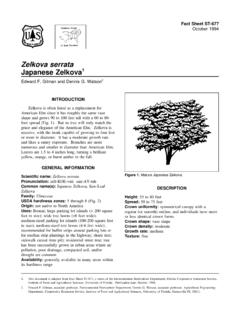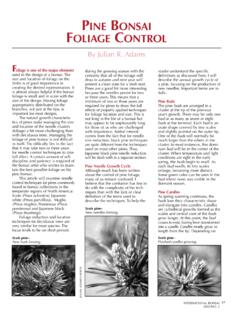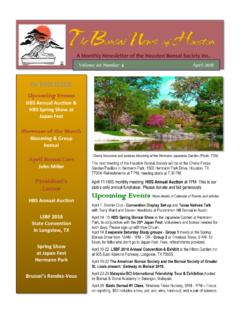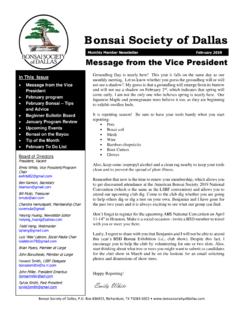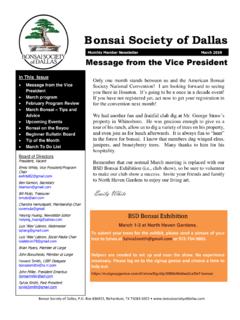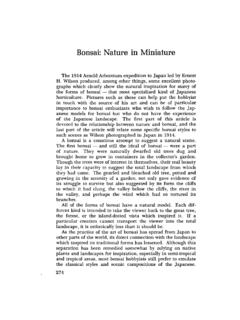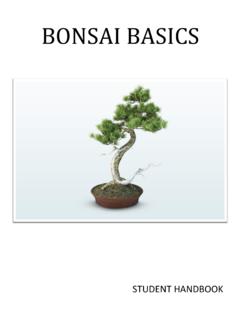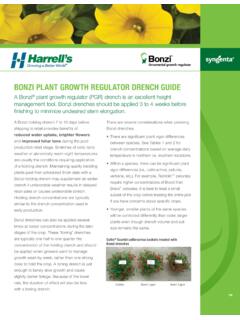Transcription of Ulmus parvifolia - University of Florida
1 Fact Sheet ST-652 October 1994 Ulmus parvifoliaFigure Chinese Elm1 Edward F. Gilman and Dennis G. Watson2 INTRODUCTIONAn excellent tree that is surprisingly under-used,Chinese Elm possesses many traits which make it idealfor a multitude of landscape uses (Fig. 1). A fast-growing, deciduous or evergreen tree, Chinese Elmforms a graceful, upright, rounded canopy of long,arching, and somewhat weeping branches which areclothed with two to three-inch-long, shiny, dark green,leathery leaves. Some specimens grow in the typicalvase-shaped elm form. In colder regions of thecountry in fall, leaves are transformed into variousshades of red, purple, or yellow.
2 The tree is evergreenin the southern extent of its range. The showy,exfoliating bark reveals random, mottled patterns ofgrey, green, orange, and brown, adding great texturaland visual interest, especially to its winter Elm can reach 80 feet in height but is moreoften seen at 40 to 50 feet, making it an ideal shade,specimen, street or parking lot tree. They look verynice planted in a grove or along a INFORMATIONS cientific name: Ulmus parvifoliaPronunciation:UL-mus par-vih-FOLE-ee-uhCommon name(s):Chinese Elm, Lacebark ElmFamily:UlmaceaeUSDA hardiness zones:5B through 10A (Fig.)
3 2)Origin:not native to North AmericaUses:Bonsai; large parking lot islands (> 200 squarefeet in size); wide tree lawns (>6 feet wide);medium-sized parking lot islands (100-200 square feetin size); medium-sized tree lawns (4-6 feet wide);recommended for buffer strips around parking lots orfor median strip plantings in the highway; reclamationplant; shade tree; small parking lot islands (< 100square feet in size); narrow tree lawns (3-4 feet wide);specimen; sidewalk cutout (tree pit); residential streettree; tree has been successfully grown in urban areaswhere air pollution, poor drainage, compacted soil,and/or drought are commonAvailability:generally available in many areas withinits hardiness document is adapted from Fact Sheet ST-652, a series of the Environmental Horticulture Department, Florida Cooperative Extension Service,Institute of Food and Agricultural Sciences, University of Florida .
4 Publication date: October F. Gilman, associate professor, Environmental Horticulture Department; Dennis G. Watson, associate professor, Agricultural EngineeringDepartment, Cooperative Extension Service, Institute of Food and Agricultural Sciences, University of Florida , Gainesville FL parvifolia -- Chinese ElmPage 2 DESCRIPTIONF igure area represents potential planting :40 to 50 feetSpread:35 to 50 feetCrown uniformity:irregular outline or silhouetteCrown shape:round; vase shapeCrown density:moderateGrowth rate:mediumTexture:fineFoliageLeaf arrangement:alternate (Fig.)
5 3)Leaf type:simpleLeaf margin:serrate; serrulateLeaf shape:elliptic (oval); obovate; ovateLeaf venation:pinnateLeaf type and persistence:deciduousLeaf blade length:less than 2 inchesLeaf color:greenFall color:purple; red; yellowFall characteristic:showyFlowerFlower color:greenFlower characteristics:fall flowering; inconspicuousand not showyFruitFruit shape:ovalFruit length:< .5 inchFruit covering:dry or hardFruit color:brownFruit characteristics:does not attract wildlife;inconspicuous and not showy; no significant litterproblemTrunk and BranchesTrunk/bark/branches:bark is thin and easilydamaged from mechanical impact; droop as the treegrows, and will require pruning for vehicular orpedestrian clearance beneath the canopy; routinelygrown with, or trainable to be grown with, multipletrunks; showy trunk; tree wants to grow with severaltrunks but can be trained to grow with a single trunk.
6 No thornsUlmus parvifolia -- Chinese ElmPage 3 Pruning requirement:requires pruning to developFigure of Chinese structureBreakage:resistantCurrent year twig color:brown; grayCurrent year twig thickness:thinCultureLight requirement:tree grows in part shade/part sun;tree grows in full sunSoil tolerances:clay; loam; sand; acidic;occasionally wet; alkaline; well-drainedDrought tolerance:highAerosol salt tolerance:moderateOtherRoots:surface roots are usually not a problemWinter interest:tree has winter interest due tounusual form, nice persistent fruits, showy wintertrunk, or winter flowersOutstanding tree:tree has outstanding ornamentalfeatures and could be planted moreInvasive potential:little, if any, potential at this timeOzone sensitivity:sensitive or moderately tolerantVerticillium wilt susceptibility:susceptiblePest resistance.
7 Long-term health usually notaffected by pestsUSE AND MANAGEMENTS elect trees with branches spaced along one is not essential that this trunk be straight. Buy fromnurseries who understand how to train and prune thistree for street and parking lot use, otherwise you maybe trimming and pruning low drooping branches on aregular which have a trunk less than about twoinches in diameter often require staking and someearly pruning to prevent leaning and blowover due to aheavy crown and unstable root system. Nurseryoperators often train trees to a single, straight trunk bystaking at an early age.
8 Leave branches on the lowertrunk during this training period to encourage caliperdevelopment on the lower trunk. Older trees look nicewith an occasional light thinning to show off thewonderful trunk and branch do not confuse it withUlmus pumila, theSiberian elm. Siberian Elm is farinferiorto ChineseElm and should not be planted, except perhaps inextreme climates such as the drier parts of theMidwest where the limits of most other trees Elm is sometimes topped in the nursery tocreate a full head of foliage, and branches originatefrom one point on the trunk. There is not enoughroom on the trunk to support this type of branchstructure, and some may split out from the tree as itages.
9 This tree may take more effort to properly trainand prune when young than some other species but itis well worth the effort. It will have a long servicelife in urban areas with proper training early root system is comprised of several verylarge-diameter roots which can grow to great distancesfrom the trunk. These are usually located fairly closeUlmus parvifolia -- Chinese ElmPage 4to the surface of the soil and can occasionally liftsidewalks. They can get into sewer lines causingdamage. But they are usually not a problem andshould not be cause to eliminate this tree from yoururban tree planting program.
10 This is among the topurban trees on most recommended tree lists in theSouth and mid-West. Occasionally, root suckersemerge from beneath the canopy and will Elm will grow in full sun on a wide rangeof soils, adapting easily to extremes in pH (includingalkaline) or moisture, and tolerates urban heat, andwind. Trees will look their best, though, when grownin moist, well-drained, fertile soil but they adapt todrought and the extremes of urban sites. Very suitablefor street tree pits, parking lot islands, and otherconfined soil cultivars are available for size and form: Catlin is dwarf; Drake , USDA hardiness zones 7 to9, has small, dark green leaves, sweeping, uprightbranches forming a rounded crown, and greater leafretention being almost evergreen in California andFlorida; Dynasty has smooth, dark grey bark, smallerleaves and is vase-shaped, with red fall color in thenorth; Frosty has a small ( ), white-margined leaf which may revert back to green.

